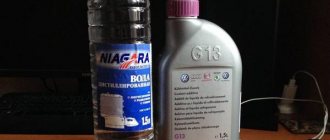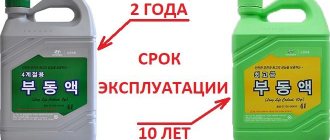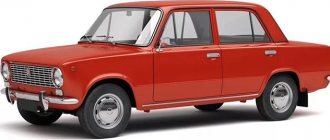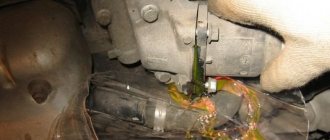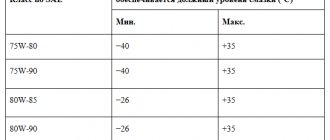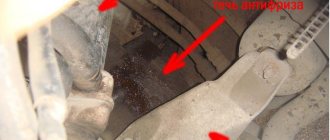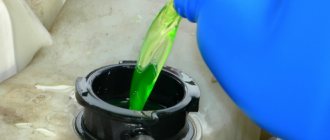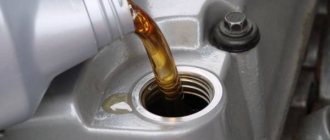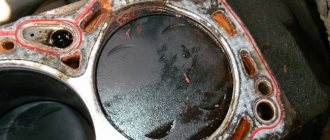To cool a car engine, liquids that have a very low freezing point are used. The general name for such liquids is antifreeze.
In Russia, a liquid called “Tosol” was used for cooling engines for a long time. And now in conversation all coolants are often called “antifreeze” for simplicity.
In modern practice, two types of Antifreeze are used for cooling - salt-based and acid-based. In order to distinguish different coolers from each other, they were painted in different colors - the first are blue or green, and the second are red. The choice of coolant type depends on the materials used in the manufacture of the engine cooling system.
The coolant contains ethylene or polypropylene glycol as a liquid component. Since the first of them is very toxic, it is preferable to use antifreeze based on polypropylene glycol, which is done by self-respecting cooler production companies.
Based on the above, it is clear that mixing antifreeze of different colors is unacceptable. To change antifreeze, it is better to completely replace the cooler in accordance with the time limits specified by the manufacturer.
The main differences between G12 antifreeze and G11
G12 is a red, or less often yellow, carboxylate antifreeze. It is characterized by a local effect, that is, if a corrosion lesion has formed in the system, then the additives localize it. This allows antifreeze to work with sufficient efficiency for a considerable period - from 5 years, and only then its additives are depleted. G11 is a silicate antifreeze. It is painted in completely different colors - blue, green, yellow, orange, and in the past sometimes even red was found. Its domestic analogue is antifreeze. It interacts with all surfaces of the system, covering all parts with a protective film. Therefore, its service life is shorter - up to three years.
When using one of these types of antifreeze first and then changing it to another, one nuance should be taken into account. Filled with antifreeze, G12 faces the problem of the old protective film and works with much less efficiency. Yes, and it will be necessary to change it in three years. And antifreeze poured after G12 instantly stops its effect. Therefore, it is advisable to always use the same brand of antifreeze. And under no circumstances should you mix these two brands! Antifreeze G12+, which has properties similar to G12, can easily mix with antifreeze. When mixed, only its lifespan suffers, dropping to 3 years, but overall mixing gives acceptable results.
In general, you should not be guided by antifreeze by its color, as is usually customary here. You should not divide them into “antifreeze”, “yellow antifreeze”, “green antifreeze”, “red antifreeze”. Instead, it is better to carefully read their composition, think about their action and compatibility with what is currently loaded.
Any ANTIFREEZE is a mixture of ethylene glycol (polypropylene glycol), water, dye and additive package.
Initially, this was a nomenclature designation for antifreeze specially developed for VAZ cars during the construction of the plant in Togliatti. The Italians were not satisfied with the quality of the Antifreeze 156 that existed at that time in the USSR; they demanded the creation of a new antifreeze. TOSOL is an abbreviation: Technology of Organic Synthesis of OL (alcohol according to chemical nomenclature). Now this name has become simply a household name. Those. Antifreeze is a type of antifreeze.
Each manufacturer uses its own package of additives, including even in the line of one manufacturer, antifreeze may differ in the number and composition of additives used. Additives can be anti-corrosion, anti-foam, reducing the impact on rubber, etc. In the 70s, European manufacturers decided to create a coolant classification. Three classes were developed.
G11 - ethylene glycol is used, usually the cheapest coolant, with a small additive package. This class was assigned the color green. By the way, colors were introduced so that liquids of different classes could be distinguished. Before this, the liquids were colorless.
G12 - ethylene glycol and carboxylate compounds are used. Due to the fact that the anti-corrosion film is created only in the hot spots, and does not cover all internal surfaces, heat removal when using this antifreeze is more effective than that of G11. Best suited for high-speed and temperature-loaded engines. Due to a more advanced package, e-liquids of this class are more expensive. This class was assigned the color red.
G13 - polypropylene glycol is used. This is a more environmentally friendly product (non-toxic, decomposes faster). Europe is pursuing environmental friendliness, which is why they create such products. The most expensive coolants. This class is assigned a yellow or orange color. In Russia, not a single manufacturer makes G13 class liquids. They are not old enough to chase the environment for that kind of money.
But most Russian and Asian manufacturers do not adhere to this classification. Take the same TCL: it has both green and red fluids of the G11 class, but they differ in the additive package (red is more advanced). Therefore, the manufacturer introduced color divisions to differentiate the product for the end customer. Take for example the original Honda antifreeze - it is made in green color (well, that’s what they wanted), but its properties correspond to the G12 class. This is where the confusion comes from. In general, don’t get hung up on the color, take at least blue antifreeze, as long as it is of high quality and matches the temperature regime of your engine (for a Honda, the boiling point at a pressure of 1.1 should be no lower than 108 degrees).
As for corrosion: it all depends on the additive package, as well as on its balance. At first, almost all lower-quality liquids provide the same protection against corrosion, but over time, in cheap products, the additives are used up, decompose, and only a mixture of glycol and water circulates in the cooling system; naturally, there is no talk of any protection. Therefore, if you fill in TCL and change it every 6-12 months, nothing bad will happen even for Honda engines, but you can buy expensive antifreeze and change it every 3-4 years. It's up to the buyer.
About mixing: it is allowed to mix liquids of classes G11 and G12 from the same manufacturer. This may cause a color change. In emergency cases (on a long trip in the absence of other options), you can mix fluids from different manufacturers, but replace them with fresh ones with a complete flush as quickly as possible. Due to the different composition of additives, they may begin to interact and precipitate, worsening the properties of the coolant.
About European manufacturers: now 90% of the European additive package market is occupied by BASF. For decades now they have been producing the so-called super concentrate for classes G11 and G12 (just a package of additives). This product is branded as Glysantin.
Differences
However, apart from some subjective opinions from car owners, antifreeze itself and modern foreign antifreeze differ from each other in components and also in established performance characteristics during use.
Antifreeze is much more aggressive in its effect on the internal elements of the engine and on the pipes, as well as on the engine cooling systems, which is why antifreeze contains a special silicate, which, as the mixture is used, is deposited on the surface of the cooling system tubes and perfectly protects the engine from the effects of corrosion .
Antifreeze itself is much weaker in its effect on the car and for this reason it does not contain silicate. That is why mixing antifreeze with the same antifreeze or replacing antifreeze with antifreeze without first cleaning and washing the pipe system in the engine can provoke corrosion of internal elements and lead to the appearance of corrosion on the engine and other contaminants in the car’s cooling system. This can disrupt engine operation and completely damage the car within a short period of time.
It is also worth considering that different types of automotive antifreeze are based on different compositions - ethylene glycol or propylene glycol plus a list of third-party additives. In addition, you should not smell antifreeze, or even try to taste it - any antifreeze for the cooling system is poison.
Antifreezes are distinguished in such areas as performance lubricating and general anti-corrosion characteristics, including average aggressiveness towards many internal elements of the engine, such as engine seals and gaskets, as well as pipe systems for supplying the coolant mixture to the engine, also differ in freezing point and boiling point.
External (including color) differences between antifreezes are expressed in the thickness and actual shade of the mixture: on sale you can see red antifreezes, blue ones, which are rarer on the shelves, and also green ones. Antifreeze is given its tint by special additives - dyes.
The dyes themselves mean the possibility of mixing one type of antifreeze with each other from different manufacturers. It is worth considering that, for example, when mixing red antifreeze with the same red antifreeze, even from another manufacturer (although this should not be done in any case), the antifreeze will not begin to foam and sediment will not form in it.
But at the same time, based on existing reviews from car owners, most often you can not worry and calmly mix antifreezes of different shades (add one to another). In any case, no one can accurately predict the outcome of this operation.
It is important to consider: cars that came to us from Japan are usually filled with light red antifreeze, but this antifreeze is not designed for cold weather and cannot be poured in Russian frosts
You can, of course, drive with such antifreeze, but it is still advisable to change it as soon as possible. At the same time, what antifreeze should be purchased for replacement is a matter of your personal preference. Some try to purchase only imported antifreeze from well-known manufacturers, some prefer domestic products and do not want to overpay. Keep in mind that when purchasing antifreeze, you should pay attention to its shade (if you only want to mix and add another antifreeze to your car).
Water deal: what happens if you mix poured antifreeze with water and a direct answer to the question
Experts warn that there is no need to rush; you need to look through the factory booklet for information about the filled emulsion and ways to restore its level. Then the question of what will happen if you mix antifreeze with water will disappear by itself. We will present multilateral situations when it is possible to add natural chemical liquid and when it is not.
A little fluid was lost
Let's say the nominal level in the tank has shifted down by 100...300 milliliters. In this case, you can confidently fill in water and not worry about the condition of the system. The balance of additives will not change, since the evaporated liquid is just water. It's worth knowing:
- Antifreeze is half water.
- Only distilled composition can be added.
- Ordinary water cannot be added due to the fact that the outcome of the interaction of the natural chemical composition with coolant additives is unknown.
- The solution from the tap is harsh and can lead to corrosion of the cooling system passages.
For your information. Many manufacturers sell concentrates. These products are precisely dissolved with distilled water. The proportions depend on the desired freezing temperature and are indicated on the packaging. The nominal ratio of diluted substances for temperate climates is 1:1.
Coolant is missing in large quantities
The best option would be to add ready-made antifreeze or diluted concentrate. If a leakage situation occurs far from points of sale, and it’s summer outside, then you can safely pour the distilled composition. As a last resort, filtered water will do.
If diluted with a large amount of water, the coolant must be replaced. Moreover, this should be done before the onset of the first cold weather. Naturally, in winter it is prohibited to resort to excessive dilution of the coolant. After all, it may freeze and the engine will require partial repairs.
How to replace?
- To replace the cooling mixture, take its concentrate and then add distilled water to it (you should purchase water at a car dealership). Most often, antifreeze is usually diluted in a ratio of 1 to 1, however, on the package with the concentrate itself there is usually a diagram for a better idea of what corresponds to what when mixed.
- It all depends on this diagram - from it you can find out whether it is possible to mix antifreeze and this particular antifreeze. However, if the schedule on the packaging does not contain the necessary information, I would not advise taking risks, since the likelihood of damaging the cooling system is quite high.
- Before purchasing, you should definitely see how well the new mixture combines with the old one. You can also mix a small volume of both, after which you can monitor whether sediment has appeared in the system pipes. And then, after draining the old mixture and thoroughly washing it, new antifreeze is actually added.
How to do this correctly?
First, you should remove the old antifreeze from the tank - it is located in the radiator and also in the cylinder block. When carrying out work, the car should be placed on a hill - this way much more of the cooling mixture will drain out. The system should be flushed with distilled water; It’s also worth adding special. means for carrying out work.
- Antifreeze should not be poured into the car to the brim, the lid should be open, then the car engine is turned on again and the air is released into the space.
- Afterwards the neck should be screwed on.
- Prepare and place a container under the cooling drain points in advance. mixtures in cars.
- Next, you should unscrew the drain valve on the cooling system. You need to open it as carefully as possible, and do this while pouring antifreeze. Perform the draining itself slowly. After you have drained the main part of the coolant. mixture, unscrew the lid.
- It is also worth paying attention to the fact that the pipe systems and tap can be located at different points, since much depends on the design solutions of the car.
- After draining the car's coolant, you should seal the cooling system by turning off the pipes and the valve. After that you can start filling in a new portion of antifreeze.
- To prevent the mixture from spilling, it is worth placing the watering can in a special expansion tank or insert it into the radiator. It is usually located under the hood;
- Next, take a container and fill it with antifreeze. This should be done gradually, while trying not to pour all of your antifreeze into the tank in one fell swoop. It is worth remembering that if the pressure is too high, a water plug may appear.
- It is also worth noting that the extension. The tank usually has a maximum fill mark and a minimum fill mark. That is why it is recommended to pour no more cooling mixture than the set level.
- When pouring antifreeze or antifreeze, it is worth screwing the cap of the expansion tank tighter.
This is essentially almost all actions. Now you understand how to properly fill in antifreeze (you can understand in more detail in the video below). After all these procedures, it is better to play it safe and start your car, allowing it to reach the required temperature.
Also check how the car's cooling system works and what condition it is in. Check the antifreeze level in it.
Any car needs coolant. The most important thing is to be able to choose it correctly. Therefore, sooner or later all new drivers are interested in whether it is possible to mix antifreeze with antifreeze? Coolant is a chemical substance necessary for gasoline and diesel engines.
The liquid is characterized by high boiling and freezing rates in the engine cooling system. Due to this, it is possible to use the machine at any ambient temperature. The coolant not only protects the engine from overheating, but also warms it up much faster at low temperatures. Antifreeze was formulated by foreign manufacturers using carboxylate technology. In addition to distilled water and ethylene glycol, it contains additives based on salts of organic acids. According to the classification, imported coolants (coolants) most often belong to organic compounds.
Cooling system diagram
The consistency of the coolant is different, which divides it into types:
- Reds.
- Greens.
- Blue.
- Yellow.
In principle, they are similar, the only differences are in composition and temperature conditions. There is an erroneous statement that color affects the chemical characteristics of the coolant. In fact, this is done to make it easier to diagnose the node. It is impossible to single out which color is better, since the main thing is not the color, but the chemical and physical properties of the antifreeze.
Which antifreeze is better?
The main thing in antifreeze is the correct proportion of additives, which prevent corrosion, changes in the viscosity of the coolant, scale formation, and foaming. Therefore, you should simply use high-quality antifreeze from reputable manufacturers.
Which is better: propylene glycol or ethylene glycol? The difference between them in terms of performance characteristics is minimal. But propylene glycol is not produced in the Russian Federation, so it costs more.
So, is it possible to add water instead of antifreeze in the summer? Yes, the car will work normally. But the consequences of using such a coolant will definitely make themselves felt sooner or later. In the best case, scale will simply appear in the radiator; in the worst case, the corrosion process will be activated, which can only be stopped at an early stage by thoroughly flushing the engine cooling system.
It is not recommended to conduct such experiments; absolutely all car manufacturers indicate that it is necessary to use antifreeze (the brand is selected depending on environmental conditions).
Guys, tell me what will happen if you add antifreeze instead of antifreeze? Antifreeze instead of antifreeze.
Similar articles
55 comments on “Antifreeze instead of antifreeze. Guys, tell me what will happen if you fill in antifreeze instead of antifreeze”
nothing will happen
What is antifreeze and how did it appear?
There is an opinion that all coolant is antifreeze, which is not entirely true. In fact, antifreeze is a subtype of antifreeze that has an outdated formula of ethylene glycol, water and inorganic acid additives. It belongs to mineral antifreeze. Despite the identity of the components, it has a different composition, which affects the performance characteristics. The disadvantage of antifreeze is that after heating to 105 °C it loses its properties.
Flushing the cooling system
The first prototype of antifreeze, oddly enough, was ordinary water. In principle, it coped with its duties well, but in the cold season it was difficult to use water in the cooling system. At low temperatures, the water became ice and could easily break the cylinders and pipes of the system. In such situations, drivers had to constantly drain and change the water or drip ethylene glycol into it. The addition of ethylene glycol helped prevent corrosion on cast iron cylinder heads. Later, when new car models went into production, it was necessary to solve the cooling problem and develop a much more efficient refrigerant. It was decided to add additives to the ethylene glycol base, which would not cause such rapid corrosion of parts, but, on the contrary, would suppress the effect of the main substance on them.
Coolant “Antifreeze” inherited its name from the scientific department of the research institute, where it was invented during the Soviet Union in 1971 . The resulting composition was used for cooling engines of the Soviet automobile industry. And since in those years the power units were made of cast iron, the antifreeze, although suitable for such engines, was ineffective. In order for its operation to be more or less safe for the cooling system, it had to be replaced every year. But after other antifreezes appeared on the shelves, antifreeze faded into the background, since the quality is at a very mediocre level.
Is it possible to fill with water?
In theory, water is no less effective in terms of heat transfer than antifreeze (both ethylene glycol and propylene glycol based). If you pour water into the cooling system, the engine will still operate normally and cool. Maybe the final temperature will be only 2 - 3 degrees higher, but there will not be a significant difference.
But only distilled water is allowed to be filled. In ordinary drinking or technical water there is too much admixture of salts and limestone, which is why scale forms. This sediment practically does not harm the metal, but it can lead to the formation of blockages in the radiator plates, which will deteriorate the cooling efficiency (and over time, microcracks will certainly form).
Difference between antifreeze and antifreeze
Let's look at the difference between antifreeze and antifreeze and is it possible to mix them? It is impossible to visually distinguish antifreeze from antifreeze. The color of antifreeze also varies; it ranges from dark blue to pink; many do not know this and believe that the substance can only be light blue. Since all coolants contain a mixture of ethylene glycol and water, this directly affects the high boiling point of up to 100 °C.
Coolant replacement
Probably the main difference can be considered a set of additives. For example, antifreeze contains only the essentials, unlike imported antifreezes, which come with a full package of lubricating, anti-foam and anti-corrosion additives. Each manufacturer uses its own additive package, which may differ in both quality and quantity. In addition, the boiling parameter of the compositions is different: for example, domestic coolant boils after 105 °C , and carboxylate coolant boils after 115 °C . Antifreeze can only be used up to 40 thousand km after it is needed and replaced, but antifreeze is produced up to 240 thousand km , so replacement is made less frequently. Also, the obvious advantages of antifreeze over antifreeze include:
- the water pump is not overloaded due to the fact that the antifreeze contains carbonates that protect the pump from shock during cavitation;
- high degree of cooling due to the fact that the additives included in it are more advanced. Antifreeze forms a protective membrane only in areas damaged by corrosion;
- chemical inertness, which prevents the formation of new compounds and deteriorates any type of surface;
- protection of aluminum parts at high temperatures.
Classification of coolants
Today you can see a variety of antifreezes in car dealerships. It all started with the fact that in the 70s, European manufacturers compiled a coolant classification of three classes:
- Mineral antifreeze, standard G11 is indicated on the packaging. They contain ethylene glycol, they are inexpensive with a simple package of additives. They are used for radiators made of aluminum and alloys based on it. This class is characterized by the color green.
- Organic antifreeze, you will find G12 on the canister. They combine ethylene glycol and carboxylate compounds. Antifreeze is marked in red and is used for high-speed and temperature-loaded engines. Suitable for radiators made of brass or copper. It is considered more effective than G11, since its film only covers areas of corrosion, and not the entire area. Since the additive package is quite diverse, its price is much higher. Can be used for up to 5 years or more.
- Lobrid G13 and G12++ . Their base is polypropylene glycol. Liquids are colored yellow or orange. They are considered environmentally friendly products, as they quickly disintegrate and do not cause harm to health. They are the most expensive coolants, mainly common in Europe; liquids of this class are not yet produced in Russia.
Is it possible to mix antifreeze with antifreeze and what will come of it?
Since both fluids consist of different elements, mixing domestic and imported coolant is prohibited. Refrigerants differ from each other not only in additives, boiling and freezing temperatures, but also in the degree of aggression towards car components. And as we know, antifreeze itself is a very aggressive substance. During the connection, a chemical reaction may occur, leading to coagulation and precipitation, clogging the ducts of the system. Clogged channels will lead to:
- to the occurrence of piston rings and to engine overheating;
- thermostat with bearing failure;
- pump a fails ;
- deformation of the cylinder head or engine block.
In addition, when mixing antifreeze and antifreeze, foaming is possible, which is extremely undesirable, as this can lead to freezing of the antifreeze or also overheating of the engine. In addition to the above, severe corrosion can occur that will simply eat up the system. In general, it should be noted that modern vehicles have a determining system, which, in the event of a mismatch of fluid in the expansion tank, simply does not allow the engine to start. Also, many people think that even if the antifreeze is multi-colored, but from the same manufacturer, it can be mixed. This is misleading, as they may differ in chemical additives. Let us repeat that color does not add chemical properties, it is simply a dye. Each manufacturer can make its own shade of the main color.
The consequences of mixing antifreeze and antifreeze
Any coolant has a brand, it is indicated in small letters on the packaging, because the color does not play a special role. To understand what kind of liquid is in front of you, you need to look for the G11 or G12 markings. Antifreezes under these standards cannot be mixed. It is permissible to combine if the base and additive package are completely identical. When the coolant is selected correctly, the engine temperature will not drop, and the cooling system will operate at the proper level. But many people get confused because there are exceptions. Below are the conditions when mixing different refrigerants is possible:
- G11 can be mixed with G11 analogues;
- G11 can be mixed with G12+;
- G11 can be mixed with G12++;
- G11 can be mixed with G13;
- G12 can be mixed with G12 analogues;
- G12 can be mixed with G12+;
- G12+, G12++ and G13 can be mixed with each other.
In general, if a driver wants to switch to another antifreeze, this is not done abruptly; the old coolant must first be drained, and the entire system must be thoroughly washed - the cylinder block, radiator and expansion tank.
Main differences
In conclusion, it is worth summarizing the differences between antifreeze and antifreeze:
- Antifreeze is a brand of antifreeze, and antifreeze itself is a general name for all coolants.
- Antifreeze contains inorganic salts, and antifreeze contains organic salts.
- The service life of antifreeze is no more than 40 thousand kilometers, while antifreeze can last 200-250 thousand kilometers.
- Antifreeze guarantees protection on the walls equal to 0.5 mm, which impairs heat transfer. As for the “competitor,” it leaves protection only in weak areas where corrosion occurs.
- Antifreeze can withstand temperatures up to 115 degrees Celsius and does not boil, while antifreeze is less resistant to high temperatures.
Can antifreeze and antifreeze be mixed with water?
It is allowed to mix antifreeze and antifreeze with distilled water, because the coolant contains about 70%. It is worth remembering that with intervention, the properties of the freezing threshold are lost, that is, in winter, the refrigerant can freeze, damage the pipes, radiator and rupture the engine. Even if the antifreeze has not completely frozen, but simply crystallized, this can contribute to the radiator leaking. You can mix water with coolant if the water has evaporated and the composition has increased its density. Mixing must be done carefully, draining all the liquid in advance, diluting it in a 1:1 ratio (in this case, the antifreeze will have a freezing point of about -40) and pouring it back into the system. If in doubt, the acceptable proportions should be indicated on the label.
What is the difference between antifreeze and antifreeze?
The concepts of “antifreeze” and “antifreeze” are often confused by car enthusiasts. However, many are sure that this is the same product. But is it? Let's consider each of them separately:
Definition:
- Antifreeze is a general name for cooling compounds, regardless of their color, series and year of manufacture.
- Antifreeze is one of the types of antifreeze that was produced in the Soviet Union. Due to the lack of competition in the market, the term took root among domestic car enthusiasts and became a household name. In fact, “TOSOL” has its own meaning: “Technology of organic synthesis of a separate laboratory.”
Performance characteristics:
- Antifreeze is a substance that provides reliable protection of walls from corrosion without affecting heat transfer. The advantages of the coolant are that it does not lose quality even after 250 thousand kilometers. In addition, the composition uses organic salts, which eliminate the appearance of sediment. The boiling point of antifreeze is 115 degrees Celsius. In practice, the average service life of such a coolant is two years or 100,000 km.
- Antifreeze also forms protection on metal walls. The disadvantage is that the thickness of the film formed is about 0.5 mm, due to which heat transfer is minimal. The result is increased fuel consumption and rapid engine wear. To avoid problems, it is recommended to change antifreeze after 35-40 thousand kilometers. Otherwise it becomes useless. Another drawback is the presence of inorganic salts (silicates, phosphates) in the composition, which over time give sediment or acquire a gel-like state. As a result, the radiator becomes clogged and the entire system requires cleaning.
